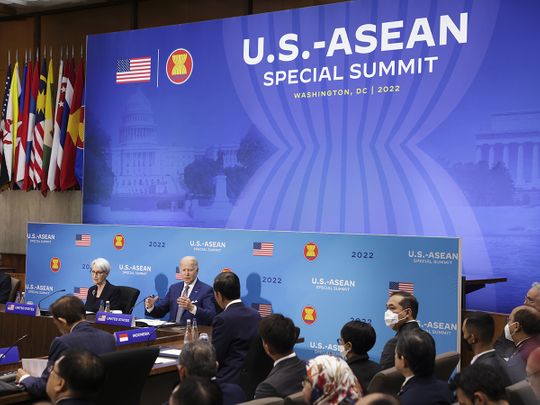
The first ASEAN — US Summit in 55 years in Washington ended Friday (May, 13, 2022). Eight of ten heads of ASEAN state or government participated.
The outgoing Philippines President Rodrigo Duterte, sent his secretary of state and Myanmar’s head of state Senior General Min Aung Hlaing is yet to invited back in to ASEAN meetings after his exclusion following the military coup last year.
The Summit was held in the backdrop of what Russia calls a ‘special military operations’ against Ukraine. US has taken upon itself to rally international support for Ukraine. According to the American media, President Biden was hoping to nudge the ASEAN leaders to be more outspoken about the invasion. This was not to be as some countries in the ASEAN maintain deep ties with Moscow while others do not want to be drawn into this partisan debate.
The joint statement issued at the end of the Summit did not use the words “Russia,” or “war.”The meeting, reflecting the unanimous position of the ASEAN member states called for “immediate cessation of hostilities” in Ukraine.
President Biden announced the nomination of Yohannes Abraham, who currently serves as chief of staff and executive secretary at the National Security Council, as the US ambassador to the ASEAN. The post had remained vacant since 2017.
Comprehensive strategic partnership
The ASEAN and the US agreed to set up a comprehensive strategic partnership. This follows ASEAN signing up similar relationship with China and Australia last year.
South China Sea (SCS) remains a point of discord between China on one side and four — Vietnam, the Philippines, Brunei and Malaysia — of the ten ASEAN states on the other. While China claims much of the SCS as its territorial waters, these four countries have competing claims.
The summit covered other topics like trade, human rights and climate change. Biden announced $150 million for Southeast Asia’s climate, maritime and public health infrastructure. China in comparison had pledged $150 billion three-year aid package for the region at its summit last year. The ASEAN leaders would not have missed the $40 billion aid package Biden is putting up for Ukraine.
An unnamed official of the Biden administration confirmed that Biden remains concerned and is focused on the need to prevent China from dominating the Asia — Pacific region. A summit of the regional leadership is indeed an opportunity to demonstrate that commitment. The meeting therefore, was as much a message of solidarity with the group and America’s attempt at seeking partnerships in the region against the China’s growing influence.
China and the ten countries are located in the same region. Both understand that it is necessary to maintain friendly relationship in the neighbourhood. Some countries in the region may allow the US as a security balancer but no more.
The American capacity as an economic partner is declining whereas China’s is rising. Much of the world has signed up to China’s Belt and Road Initiative (BRI). America’s alternative offered to Europe initially in ‘Build Back Better” plan has proven to be a fizz only.
The US may be the biggest foreign investor in the region but the two-way trade in 2020 according to the White House statement is $360 billion. Signifying the growing mutual engagement, China’s bilateral trade with the region was $685 billion during the same period — nearly double that with the US.
The region is integrating while the US is distancing itself economically. The US withdrew from Trans-Pacific Partnership (TPP) when it was nearly ready for launch. Rest of the regional states went ahead and signed it as Comprehensive and Progressive Agreement for Trans-Pacific Partnership (CPTPP). China, earlier excluded has formally applied to join this agreement. Similarly, the US chose to stay out of Regional Comprehensive Economic Partnership (RCEP), whereas China is a founder member — integrating with one of the most dynamic economic partnerships in the world.
Singapore’s Prime Minister Lee Hsein Loong, whose country is the most western oriented among the ASEAN states, admitted that the American participation “in the Asia-Pacific cannot be only limited to security and defence. It must also consist of economic cooperation,” an area in which the US has been lagging behind.
It is in the best interest of both US and China that ASEAN retains its freedom and continues to provide bridge for connecting big powers towards peace and economic growth in the region and beyond.
Sajjad Ashraf served as an adjunct professor at the Lee Kuan Yew School of Public Policy, National University of Singapore from 2009 to 2017. He was a member of the Pakistan Foreign Service from 1973 to 2008 and served as an ambassador to several countries.










